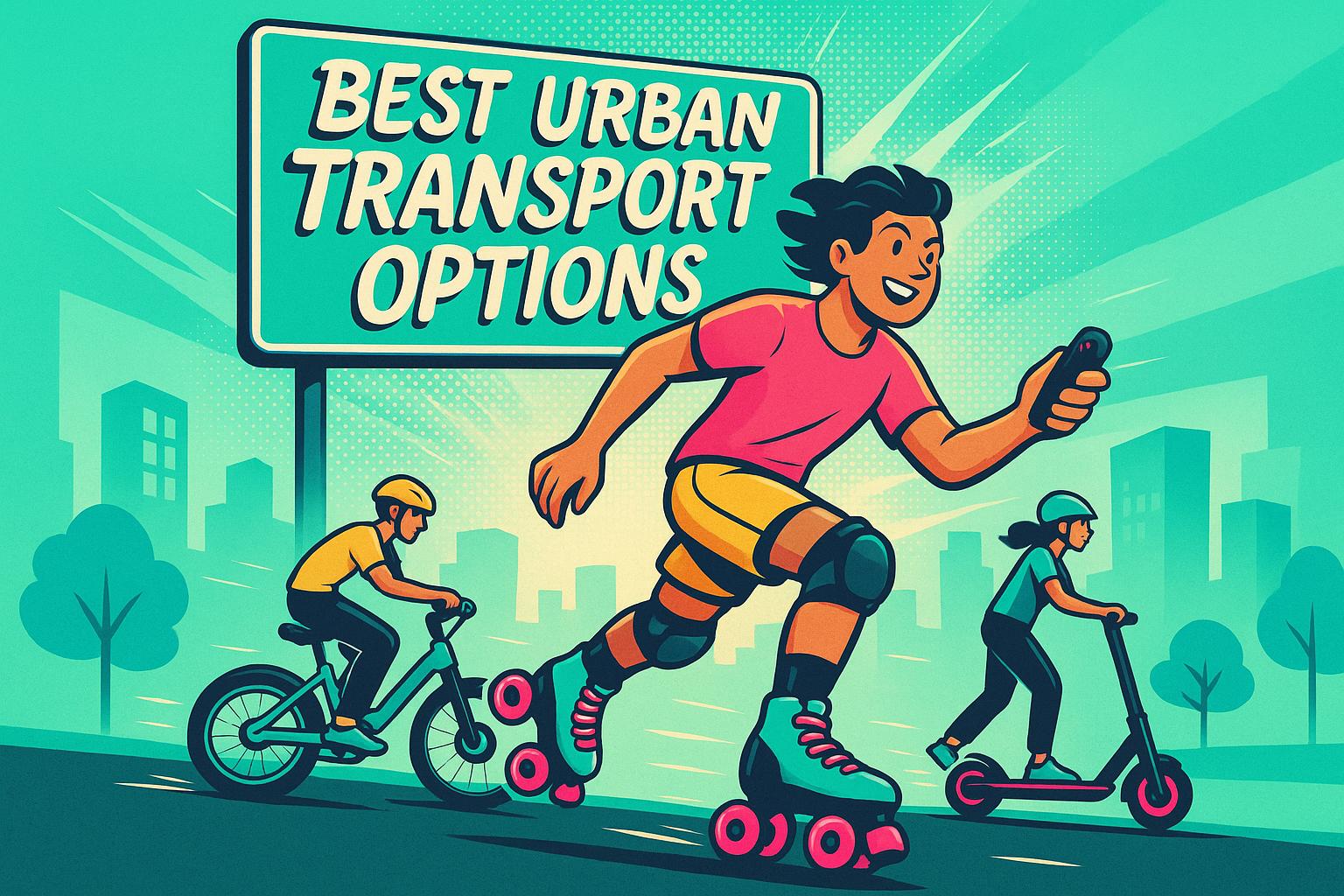Electric skates are a cost-effective way to cut transportation expenses. They’re cheaper to buy, maintain, and operate than cars or public transit, making them a smart choice for short trips. Here’s how they save you money:
- Fuel and Transit Savings: Electric skates cost just $0.003 per mile, compared to $0.086 for gas cars. You can save hundreds on gas or transit fares annually.
- Low Maintenance: Minimal upkeep costs - no oil changes or engine repairs. Basic maintenance can be done for under $20.
- No Parking Fees: Avoid monthly parking fees that can range from $50 to over $400, saving thousands yearly in urban areas.
- Affordable Upfront Cost: At $599, they’re far cheaper than cars or e-bikes and pay for themselves in months through reduced expenses.
- Protect Your Car: Reduce wear and tear on your vehicle by using skates for short trips, lowering repair and maintenance costs over time.
Electric skates are lightweight, portable, and ideal for urban and suburban commutes, offering a practical way to save money while avoiding the hassle of traditional transportation methods.
I swapped my roller skates for electric skates. This was my experience
1. Cut Fuel and Public Transit Costs
Electric skates can help you save money right away by cutting out fuel costs and reducing what you spend on public transit for short trips.
Fuel Cost Savings
Using electric skates is incredibly cheap - about 29 times less expensive than driving a gas-powered car. To put it in numbers, electric skates cost just $0.00308 per mile, compared to $0.086 per mile for a gas-powered vehicle. At an average electricity rate of $0.13 per kWh in the U.S., a full charge for electric skates costs less than five cents and provides up to 9 miles of travel.
Here’s an example: If you typically drive 5 miles a day for errands or commuting, you're spending roughly $0.43 daily on gas. Switching to electric skates would drop that cost to just $0.015 per day in electricity - saving you about $12.75 each month.
Lower Public Transit Costs
Public transit fares can vary depending on where you live, but the savings from using electric skates can be substantial. For instance, in San Francisco, a single Muni ride costs $2.85, and a monthly pass runs around $86. In the Santa Clara Valley, VTA rides are $2.50 each, with monthly passes priced at $90. Similarly, AC Transit in the Bay Area charges $2.50 per local ride, with 31-day passes costing $90.
If you take two public transit trips daily at $2.50 each, your monthly cost adds up to $150. By replacing just half of those trips with electric skates, you could save around $75 every month.
How It Adds Up
Electric skates are incredibly efficient, with research showing that $1 of electricity can power them for 350 to 900 miles. For most users, the yearly electricity cost is only about $7.30. They not only help you avoid traffic but also slash your transportation costs significantly.
2. Low Vehicle Maintenance Costs
Electric skates are refreshingly low-maintenance compared to cars. Their straightforward design means you’ll rarely need professional servicing, saving both time and money.
Easy Maintenance Tips
Keeping your electric skates in top shape doesn’t take much effort. Use a soft brush and dry cloth to clean them, check the wheels and bearings regularly, and charge the battery responsibly - avoiding overcharging to preserve its lifespan.
For storage, choose a dry, room-temperature spot away from direct heat. If you’re not using them for a while, give the battery a monthly charge to keep it healthy. Simple checks like tightening screws, inspecting the deck for cracks, and ensuring everything is aligned can go a long way in maintaining smooth performance.
Save Big on Maintenance
The simplicity of electric skates translates to major cost savings. For perspective, studies reveal that electric vehicles cost about 40% less per mile than gas-powered cars, with maintenance averaging 6 cents per mile compared to 10 cents for traditional vehicles. Given their even simpler mechanics, electric skates likely cost even less to maintain, making them a budget-friendly alternative.
No More Expensive Repairs
Unlike cars, electric skates spare you from pricey tasks like oil changes, engine tune-ups, and transmission repairs. Regenerative braking technology also extends the lifespan of brakes. Most maintenance tasks - tightening bolts or cleaning bearings - can be done at home for less than $20.
These minimal upkeep costs make electric skates an even smarter choice for those looking to save money in the long run.
3. Skip Parking Fees
Parking in major U.S. cities can be a financial headache. With electric skates, you can avoid the hassle of hunting for parking spots and the steep fees that come with them. This perk adds to the other money-saving advantages of owning electric skates.
The Real Cost of Urban Parking
Parking fees in U.S. cities can vary significantly. For example:
- New York City: Starting at $443.51 per month
- San Francisco: Around $300 per month
- Seattle: Roughly $250 per month
- Chicago: About $143 per month
- Tulsa: A more modest $21.70 per month
Other cities like Boston, Miami, and Washington D.C. typically fall in the $150 to $225 monthly range.
How Much Can You Save in a Year?
Consider this: If you live in New York City, you could spend a staggering $5,322 annually on parking. In cities like San Francisco and Seattle, the yearly costs are around $3,600 and $3,000, respectively. Even a relatively low fee of $50 per month still adds up to $600 annually. By switching to electric skates, you can kiss these expenses goodbye.
It’s More Than Just the Monthly Fees
Parking doesn’t just cost money - it eats up your time, too. On average, drivers spend 17 hours a year searching for parking, costing them an additional $345 annually. In some congested cities, this figure can skyrocket to 107 hours and $2,243 per year. Electric skates eliminate this wasted time and extra expense.
Real-World Savings
Let’s break it down with an example. If you work in downtown San Francisco and pay $25–$30 per trip for parking, skipping just three trips a week could save you around $2,340 annually. In cities with higher parking rates, your savings could exceed $4,000 a year. That’s a big chunk of change to keep in your pocket!
sbb-itb-bf837b9
4. Low Initial Purchase Price
Adding to their cost-saving advantages, the upfront price of electric skates makes them even more appealing. They provide an affordable gateway into the world of personal electric transportation.
How Electric Skates Compare to Other Transportation Options
Consider the alternatives: a new car typically costs between $25,000 and $50,000, while a used car might set you back $10,000 to $20,000. Even quality e-bikes range from $1,000 to $5,000.
Electric skates completely shift this dynamic. Priced at just $599, they are significantly more affordable than cars or high-end e-bikes. Plus, their portability and ease of storage make them a practical choice for navigating urban environments.
Quick Return on Investment
The low upfront cost of electric skates translates into fast savings. For instance, if you spend about $100 a month on public transportation, these skates could pay for themselves in just six months. If your monthly expenses include gas, parking, or rideshare services, the break-even point is even faster.
Unlike cars, electric skates are a one-time purchase. There’s no need to worry about monthly payments, insurance, or registration fees. Once you buy them, every ride helps you save more.
This affordable price tag makes electric skates a smart choice for urban commuters seeking to cut transportation costs without a hefty initial expense. They strike a great balance between affordability and practicality, making them an attractive solution for everyday commuting.
5. Less Wear on Personal Vehicles
Cutting down on car usage with electric skates doesn’t just save on fuel and maintenance - it also protects your vehicle investment. Every mile you drive adds to wear and tear, increasing maintenance costs over time. By opting for electric skates for short trips, you can trim down your car’s mileage and reduce long-term expenses. Plus, it eases the strain on key components of your car.
Why Short Trips Are Tough on Cars
Short trips are surprisingly harsh on vehicles. Engines don’t get the chance to reach their ideal operating temperature, which can lead to increased wear. Stop-and-go traffic during these short drives also puts extra pressure on brakes, transmissions, and other engine parts. Switching to electric skates for these errands spares your car from this kind of stress, ultimately reducing the need for frequent repairs.
The Maintenance Savings Add Up
The financial benefits are clear: Consumer Reports highlights that owners of battery electric vehicles spend about half as much on repairs and maintenance compared to those with traditional gas-powered cars. For gas vehicles, the average maintenance and repair cost is $0.061 per mile, while electric options cost just $0.031 per mile. If you reduce your annual mileage by 33% - say from 12,000 miles to 8,000 - you could save around $244 a year on maintenance alone.
Prolonging Your Car’s Lifespan
Fewer miles on your car don’t just save money now - they also help your vehicle last longer.
"Regular maintenance helps to prolong the life of a vehicle. By keeping the engine, transmission, brakes, and other critical components in good condition, businesses can delay the need for costly replacements and keep their fleet operational for longer periods."
By using electric skates for short trips and errands, your car avoids unnecessary engine strain, brake wear, and transmission cycles. This lighter usage pattern can add years to your vehicle’s lifespan, delaying expensive repairs and preserving its value.
Electric skates offer a smart way to reduce wear on your car while still giving you the flexibility for longer drives or bad weather when needed.
Cost Comparison Table
In the U.S., the average annual transportation cost is about $12,295, with lower-income households allocating up to 30% of their after-tax income to these expenses.
Here’s a breakdown of key cost factors for typical American commuters:
| Transportation Method | Initial Cost | Annual Fuel/Transit | Maintenance | Insurance | Parking | Total Annual Cost |
|---|---|---|---|---|---|---|
| Car Ownership | $47,000 (new) / $33,000 (used) | $2,043 | $500–$1,000 | - | - | $12,297 |
| Public Transit | $0 | $600–$1,584 | $0 | $0 | $0 | $600–$1,584 |
| Electric Skates | $400–$800 | $36–$108 | $100–$200 | $60–$180 | $0 | $196–$488 |
Note: For car ownership, the "Total Annual Cost" of $12,297 includes depreciation, financing, and other fixed costs that aren’t listed separately.
The numbers clearly highlight how electric skates drastically reduce transportation expenses compared to cars or public transit.
On a monthly basis, car commuters spend about $170 on operating expenses, while electric skate users spend just $20–$50. Over the course of a year, this difference can lead to savings of more than $1,400 on commuting costs alone.
Geographic factors also play a role in transportation costs. For instance, car commuters in Miami might spend around $2,656 annually, whereas New York City public transit users could pay up to $1,584. Meanwhile, electric skates maintain consistently low costs regardless of location, with a full charge costing just $0.10–$0.30.
When comparing per-mile expenses, cars average 12 cents per mile, while electric skates cost only 4–10 cents per mile. This translates to annual savings of over $1,400 for commuters, making electric skates a cost-effective alternative. Their lower per-mile cost can quickly offset the upfront purchase price when compared to the recurring expenses of car ownership or public transit.
This comparison demonstrates how electric skates not only reduce recurring costs but also combine low energy consumption with minimal maintenance and insurance expenses. For daily commutes and short trips, they offer a practical and economical solution.
Conclusion
Electric roller skates offer a practical way to cut down on transportation costs. By reducing fuel expenses, transit fees, and maintenance costs - not to mention eliminating parking charges - they provide an affordable option for getting around. Their relatively low purchase price and ability to minimize wear and tear on cars make them even more appealing.
Beyond financial savings, these skates bring real-world convenience. Their lightweight and portable design makes them easy to carry, while their zero-emission operation allows riders to dodge traffic jams and contribute to a greener lifestyle. They’re especially suited for quick trips in urban settings.
For those living in cities or suburbs, electric roller skates are a budget-friendly and efficient alternative to traditional modes of transportation. With low running costs and minimal upkeep, they’re a great fit for students, young professionals, or anyone aiming to lower their travel costs and reduce their environmental footprint.
The market for electric roller skates is also on the rise, with an expected annual growth rate of about 4.40% through 2033. This growth reflects the increasing interest in eco-friendly personal mobility options. As shown in the cost comparison table, these skates are not just economical - they’re a smart choice for modern, sustainable commuting.
FAQs
How do electric skates save money compared to other personal electric transportation options?
Electric skates offer a wallet-friendly and practical solution for personal transportation. Priced between $400 and $600, they’re a more economical alternative to high-end e-scooters, which can set you back as much as $1,500. For anyone trying to keep initial costs low, this makes electric skates an appealing choice.
What sets them apart is their lightweight and portable design. Perfect for short trips or last-mile commutes, they’re much easier to carry and store compared to bulkier options like e-scooters. This portability makes them especially handy for navigating urban areas in the U.S., where space and convenience are key. Electric skates hit the sweet spot of being budget-friendly, easy to use, and practical for city life.
How can I maintain my electric skates to keep them running smoothly and lasting longer?
Taking care of your electric skates doesn’t have to be complicated, but a little routine maintenance can go a long way in keeping them running smoothly and lasting longer. Start with the battery - store it in a cool, dry spot and steer clear of extreme heat or freezing temperatures, as both can reduce its lifespan. When charging, aim to keep the battery level between 40% and 80% if you’re not using it regularly, and avoid letting it drain completely.
Don’t forget about the wheels and bearings. Give them a regular check-up and clean off any dirt or debris to maintain smooth performance. While you’re at it, inspect connectors and tighten any screws or parts that might have loosened over time. With just a bit of effort, your electric skates can stay in great condition for years of dependable fun.
How do electric skates support a more eco-friendly commute compared to traditional transportation?
Electric skates offer a more eco-friendly option compared to cars or buses for getting around. They consume far less energy, emit no pollutants directly, and play a role in cutting down air pollution - particularly in crowded cities. Plus, if you charge them using renewable energy sources, their impact on the environment becomes even smaller.
On top of that, electric skates can help ease traffic jams, which in turn helps lower overall pollution levels. Opting for electric skates for short trips doesn’t just save you money - it also supports a cleaner and healthier environment.




Leave a comment
All comments are moderated before being published.
This site is protected by hCaptcha and the hCaptcha Privacy Policy and Terms of Service apply.